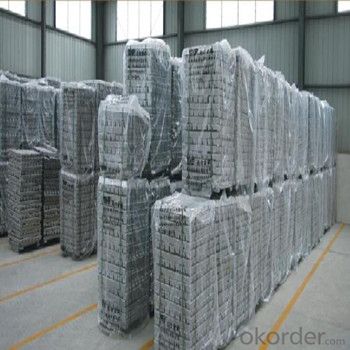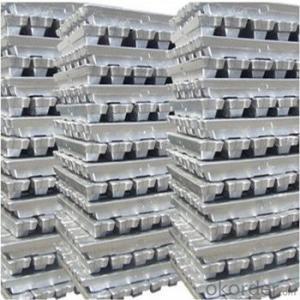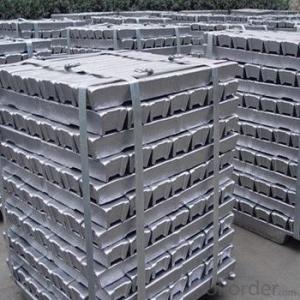Aluminum Pig/Ingot With High Purity 99.7%
- Loading Port:
- China main port
- Payment Terms:
- TT OR LC
- Min Order Qty:
- 1000 m.t.
- Supply Capability:
- 100000 m.t./month
OKorder Service Pledge
OKorder Financial Service
You Might Also Like
Pure Aluminum Pig/Ingot Used for Industry
1.Structure of Aluminum Pig/Ingot
A material that has been cast into a shape in order to be transported and processed easier than in an unprocessed form. An ingot is typically rectangular in shape, which allows it to be stacked. Ingots are most commonly associated with metals, with ingots of gold held in the vaults of banks and brokerages being popular images.
Aluminum Ingot is with the AL as the main chemical composition.Aluminum Ingot is used for industry,such as automobile,pinning and weaving,electron broadly and so on. Aluminum Ingot has the following advantages: easy control and operation, fast melting.
2.Main Features of the Aluminum Pig/Ingot
•High Purity
•Easy control and operation
•High strength
•Fast melting
•Competitive price
•Best Service
3.Aluminum Pig/Ingot Images


4.Aluminum Pig/Ingot Specification
Grade | Chemical Composition % | |||||||||
Al≥ | impurities ≤ | |||||||||
Si | Fe | Cu | Ga | Mg | Zn | Mn | others | Sum | ||
Al99.9 | 99.90 | 0.50 | 0.07 | 0.005 | 0.02 | 0.01 | 0.025 | - | 0.010 | 0.10 |
Al99.85 | 99.85 | 0.80 | 0.12 | 0.005 | 0.03 | 0.02 | 0.030 | - | 0.015 | 0.15 |
Al99.7 | 99.70 | 0.10 | 0.20 | 0.010 | 0.03 | 0.02 | 0.030 | - | 0.030 | 0.30 |
Al99.6 | 99.60 | 0.16 | 0.25 | 0.010 | 0.03 | 0.03 | 0.030 | - | 0.030 | 0.40 |
Al99.5 | 99.50 | 0.22 | 0.30 | 0.020 | 0.03 | 0.05 | 0.050 | - | 0.030 | 0.50 |
Al99.00 | 99.00 | 0.42 | 0.50 | 0.020 | 0.03 | 0.05 | 0.050 | - | 0.050 | 1.00 |
5.FAQ of Aluminum Pig/Ingot
We have organized several common questions for our clients,may help you sincerely:
①How about your company?
A big and famous and professional manufacturer & supplier of Aluminum Pig/Ingot, is one of the one of the large-scale professional investment Aluminum Pig/Ingot production bases in China.It have focuses on producing the Aluminum Pig/Ingot production for many years and gotten rich experience.Annually lagrge amount of Aluminum Pig/Ingot production are exported to markets in Europe,America and Japan. The quality and service have also gotten OEM service is available according to customer’s requirements.
②How to guarantee the quality of the products?
We have established the international advanced quality management system,every link from raw material to final product we have strict quality test;We resolutely put an end to unqualified products flowing into the market. At the same time, we will provide necessary follow-up service assurance.
③How long can we receive the product after purchase?
In the purchase of product within three working days, We will arrange the factory delivery as soon as possible. The pecific time of receiving is related to the state and position of customers.Commonly 7 to 10 working days can be served.
- Q: How to make aluminium box into aluminium ingot?
- The problem of aluminum is not high. It can be dissolved directly in a dry pan, but it should not be dissolved directly because the aluminum ingot is pure aluminum, and the aluminum case should have impurities.The smoke isn't too big.
- Q: What industries use aluminum ingots?
- Several industries use aluminum ingots due to their versatile properties and wide range of applications. Some of the major industries that extensively rely on aluminum ingots include: 1. Automotive Industry: Aluminum ingots are used in the manufacturing of various automotive components such as engine blocks, wheels, frames, and body panels. Aluminum's lightweight nature, corrosion resistance, and excellent thermal conductivity make it a preferred choice for enhancing fuel efficiency and reducing vehicle weight. 2. Aerospace Industry: Aluminum ingots find extensive use in the aerospace industry for manufacturing aircraft structures, wings, fuselage panels, and other components. Aluminum's high strength-to-weight ratio makes it ideal for building lightweight aircraft that can withstand the stresses and strains of flight. 3. Construction Industry: The construction sector utilizes aluminum ingots for various applications such as windows, doors, roofing, and cladding systems. Aluminum's corrosion resistance, durability, and aesthetic appeal make it a popular choice for modern architectural designs. 4. Packaging Industry: Aluminum ingots are widely used in the packaging industry to produce aluminum foils, cans, containers, and closures. Aluminum's excellent barrier properties, lightness, and recyclability make it a preferred material for preserving and protecting food, beverages, pharmaceuticals, and other perishable items. 5. Electrical Industry: Aluminum ingots are extensively used in the electrical industry for manufacturing power transmission cables, electrical conductors, and wiring systems. Aluminum's high electrical conductivity, low weight, and cost-effectiveness make it a suitable alternative to copper in many electrical applications. 6. Marine Industry: Aluminum ingots are employed in the marine industry for fabricating boat hulls, masts, decks, and various other components. Aluminum's corrosion resistance, lightness, and durability make it a preferred choice for constructing vessels that can withstand harsh marine environments. 7. Consumer Goods Industry: Aluminum ingots are utilized in the consumer goods industry for manufacturing a wide range of products such as cookware, furniture, appliances, and electronic devices. Aluminum's thermal conductivity, non-toxicity, and recyclability make it a popular material for consumer goods. These are just a few examples of the industries that heavily rely on aluminum ingots. Due to its numerous advantageous properties, aluminum is widely used in various other sectors such as machinery, transportation, energy, and even in art and design.
- Q: How are aluminum ingots protected from corrosion?
- There are several methods available to protect aluminum ingots from corrosion. One of these is applying a protective coating or film to the surface of the ingots. This coating acts as a barrier, preventing direct contact between the aluminum and the environment and reducing the risk of corrosion. Coatings can include paint, lacquer, or specialized epoxy coatings. Another method is anodization, which involves an electrochemical process that creates a thick oxide layer on the ingots' surface. This oxide layer not only improves the appearance of the ingots but also provides a strong defense against corrosion. Anodization can be done using different techniques, such as sulfuric acid anodizing or chromic acid anodizing, depending on the desired level of protection. In addition, proper storage and handling practices are crucial in protecting aluminum ingots from corrosion. It is important to store the ingots in a dry and well-ventilated area to minimize moisture exposure. They should also be stacked and stored in a way that allows air circulation to prevent the formation of stagnant water or condensation. Regular inspections and maintenance are necessary to detect any signs of corrosion early on and take appropriate action to address it. To sum up, protecting aluminum ingots from corrosion requires a combination of protective coatings, anodization, and proper storage and handling practices. By implementing these measures, the durability and quality of aluminum ingots can be preserved, ensuring their suitability for various applications.
- Q: What are the benefits of using aluminum ingots in the construction of lightweight structures?
- The benefits of using aluminum ingots in the construction of lightweight structures include their excellent strength-to-weight ratio, corrosion resistance, and recyclability. Aluminum is a lightweight metal that offers high strength, allowing for the creation of sturdy structures with reduced weight. Its corrosion resistance ensures durability and longevity, especially in outdoor applications. Additionally, aluminum is highly recyclable, making it an environmentally friendly choice.
- Q: What is the average weight of an aluminum ingot?
- The size and shape of an aluminum ingot can cause its average weight to differ. Nonetheless, a widely adopted standard weight for aluminum ingots is approximately 22.7 kilograms or 50 pounds. This weight is frequently employed in the industry to facilitate measurement and transportation. It should be emphasized that the actual weight of an aluminum ingot may slightly differ due to factors like impurities or discrepancies in the manufacturing process.
- Q: Can aluminum ingots be customized for specific applications?
- Yes, aluminum ingots can be customized for specific applications. Aluminum is a highly versatile metal that can be easily manipulated to meet various requirements. The customization process typically involves alloying the aluminum with other elements to enhance its properties such as strength, hardness, corrosion resistance, and thermal conductivity. Additionally, the ingots can be subjected to various heat treatment processes like annealing, quenching, and tempering to further modify their properties. This allows for the production of aluminum ingots that are tailored to specific applications, ranging from automotive parts and aerospace components to construction materials and consumer products.
- Q: Pop can recovery aluminium ingot
- As far as I know, without such special equipment, the national general practice is to use small furnace crucible to produce, products produced in the industry is commonly known as "coke ingot.". In general, the main customers are made of raw materials for the recycled aluminum plant. The price depends mainly on the composition and physical quality.
- Q: What aluminum factories are there in Guangdong and Foshan?
- Cheap comparison, if the quality can price in the medium level, but can be at ease, is called a penny goods.
- Q: Can aluminum ingots be used in the production of jewelry?
- Yes, aluminum ingots can be used in the production of jewelry. However, aluminum is not a commonly used material for jewelry due to its low melting point and softness. It is often used in costume jewelry or as a base metal for plating.
- Q: Who knows but also can do aluminium ingots what products?
- Made of aluminum ingot is only the intermediate process, convenient transportation, adjustment of ingredients, etc.Also, a lot of scrap metal recycling scrap. Mainly re refining recycled, made of sheet bar form ingots
Send your message to us
Aluminum Pig/Ingot With High Purity 99.7%
- Loading Port:
- China main port
- Payment Terms:
- TT OR LC
- Min Order Qty:
- 1000 m.t.
- Supply Capability:
- 100000 m.t./month
OKorder Service Pledge
OKorder Financial Service
Similar products
Hot products
Hot Searches
Related keywords




























